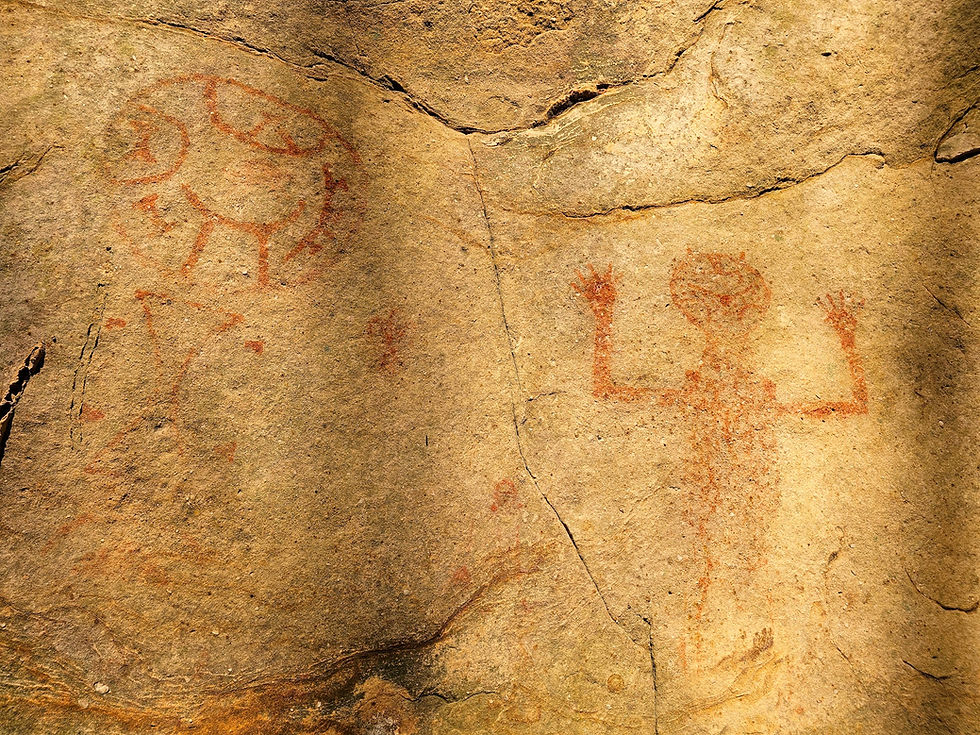As one of merely two surviving prehistoric Native American pictograph sites in Kentucky (Deer Pictographs in Letcher County being the other), Asphalt Rock Pictographs in Edmonson County provide a fascinating glimpse into a culture that once inhabited the Green River Valley long ago. Attributed to either the Mississippian culture (1000 AD to 1540 AD) or Fort Ancient culture (1000 AD to 1750 AD), these stunning works of art retain an air of mystery and awe, and a glimpse into Kentucky's rich Native American past.

Reaching the panel is fairly easy, however, since it is on private property, visitors will need to obtain permission from the landowner before venturing out. After receiving permission, from the River Rd/Davis Ferry Rd and Highway 655/Segal Rd intersection, located at coordinates 37.189107, -86.361422, follow the packed gravel River Rd/Davis Ferry Rd south for precisely 0.4 miles and park on either side of the road. If you reach a small turnaround on the left side of the road, you have gone too far.

Once parked, you should notice a large rockshelter in the woods, approximately 250 feet to the left and slightly uphill. The rockshelter is easy to locate when the leaves are off the trees, but in the summer months it will be challenging to view from the road.

After walking uphill for no more than 250 feet, you will arrive at the rockshelter shown in the photo below. The pictographs are located near the left end of the shelter, roughly eight feet above ground level. While the area in front of the rockshelter has undergone exensive and illegal excavations by those searching for Native American artifacts, the panel itself maintains an impressive state of preservation, free from any indications of graffiti or defacement.

Among the discernible images on the panel, one depicts an anthropomorphic (human-like) figure, possibly resembling a masked shaman or supernatural being, its arms bent at 90-degree angles and hands raised high. To the left of this figure, near its waist, a small human-like face and what appears to be some sort of tool or weapon can be observed, although faint.

Numerous researchers have proposed that the anthropomorphic figure displays feline-like features, but as with most prehistoric rock art, the artist's intentions will likely never be known. The close up photo below reveals some of the markings on the figure's head, which includes horns or pointed ears, possibly squinty eyes and rounded nose, and more.

To the left of the anthropomorph, there is a circular shield-like depiction, perhaps symbolizing warfare or holding some cosmological significance. Within this object are unknown symbols, which appear to be in zones.
Immediately below the shield-like depiction, once stood an hourglass-shaped figure, however, today all that remains is the upper portion with the lower section having been eroded over time. Both the circular and hourglass-shaped representations were once outlined, but that outline has also eroded over time.

Lastly, the portrayal of a small zoomorphic (animal-like) figure, likely representing a bird, can be observed immediately to the right of the panel's circular and hourglass-shaped depictions. All of the rock art at the Asphalt Rock site was created utilizing red ochre, a natural pigment derived from iron oxide rich clay, recognized as the world's oldest known natural pigment.

Pictographs in eastern North America, particularly in the southeast, are exceptionally scarce, largely due to environmental influences. The damp and humid climate of the region has swiftly erased the majority of prehistoric pictograph sites over the centuries. Thankfully, the Asphalt Rock Pictographs have endured, yet they remain vulnerable to natural erosion and human defacement. When exploring the site, please take only photos, leave behind only footprints, and refrain from touching the rock art. Human skin oils can expedite the erosion process. Let's preserve the fascinating rock art for others to enjoy for as long as nature allows.
_edited.png)









































This site is on private property and is not open to the public. It is irresponsible to give directions to this.